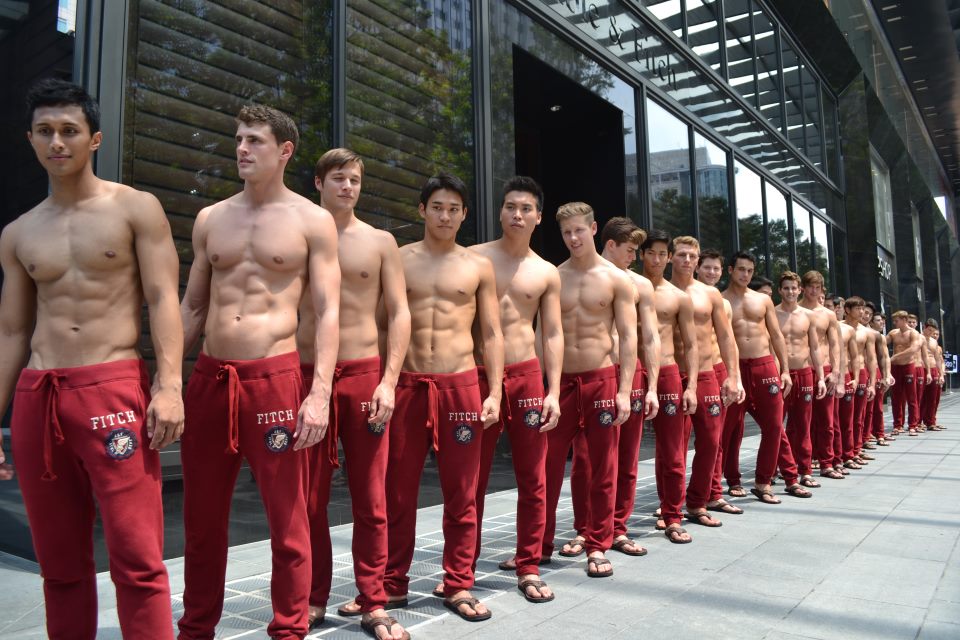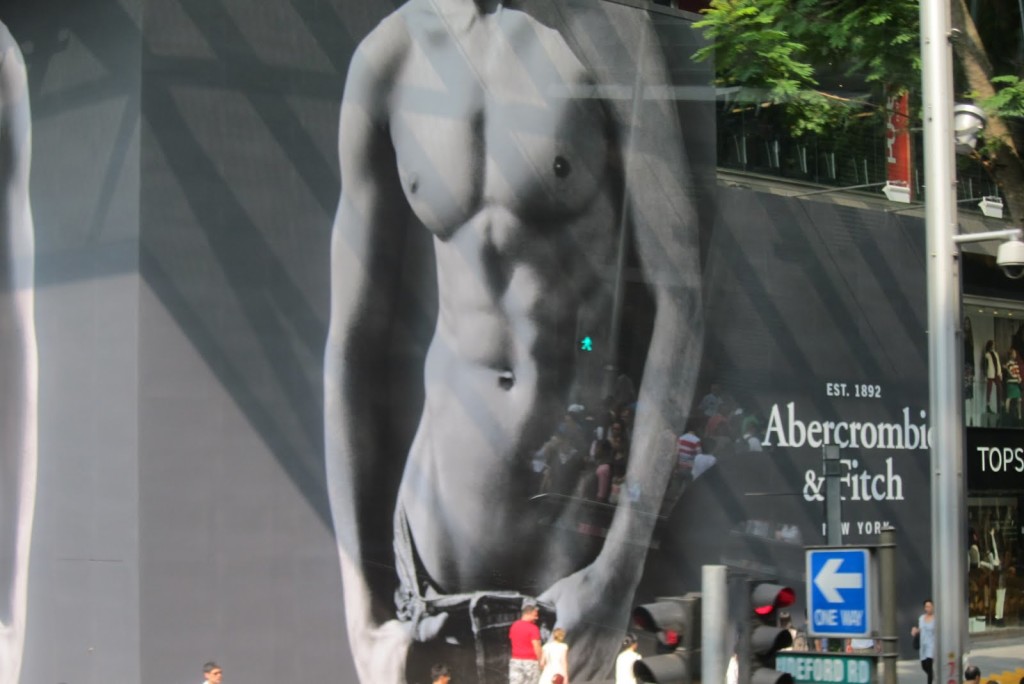
Everybody talked about the shirtless Abercrombie & Fitch greeters in 2011 (Courtesy of A&F)
Let’s talk about sex in advertising – one of the longest running meme in the history of ads.
Time and time again, the topic has ignited heated discussion amongst marketers, manufacturers and moralists alike.
Does sex sell? Would a sexy ad have a better chance of grabbing the attention of one’s target audience? Or will it just be too “been there, done that” to have any effect?
Back in December 2011, the store opening of Abercrombie & Fitch created a ruckuss here in sunny Singapore.
Many have “oohed” and “aahed” at their use of muscular half-naked guys in red pants, flexing their bare wares for all to see. Hired by Abercrombie & Fitch in Singapore for their store opening, they have created a buzz on Facebook, especially amongst the fairer sex.
Of course, this isn’t the first time that A&F, renowned for using sex in their selling, has created a sensation. The uber fashion brand also created ruckus in Orchard Road with a huge and “indecent” half naked torso.
Of course, girls have always been the subject of erotic imagery in ads, much more than than guys. A 2011 example from PETA (well known for using nude celebrities in their campaign against animal cruelty) is seen below:

Courtesy of Trends Updates
The question I want to ask, however, is this:
Does sex in advertising sell? More importantly, will it work for your brand?
Triggering the Lizard Brain
Well, for a start, using half-naked models or sexual imagery certainly helps in grabbing one’s attention in a highly cluttered consumer landscape. Like love, food, and fresh air, sex is one of the instinctive urges wired into our primitive brain. Studies have shown that these effects influence both our physiological and cognitive senses – in other words, both involuntary and voluntary responses.
Also known as the lizard or reptilian brain, the use of sexual imagery acts on the primal stimulus in our brain. This neurological trick makes it almost like an unthinking behaviour – a reflex response if you may.
Manipulating the Media
Having overtly sexual innuendoes, nudity or visual images of physical attraction also generates buzz as seen in the A&F example above. The more sensational the marketing communication efforts, the more publicity they would generate – at least during the short term. Some of these efforts would even go viral online, like the example of A&F above.
When Does Sex Really Sell?
Certain brands were also built on sex (or at least in its portrayal). Calvin Klein, Victoria’s Secret, and more recently Abercrombie & Fitch consistently employ highly sexualised images to generate their business. According to this article, sex may work for products with a sex-related brand benefit (eg condoms for instance).
Antagonising Activists
However, there are some dangers inherent in this “bedroom” game.
First, the strong reactions cited above are often negative and mostly by women. For years, feminist groups like AWARE in Singapore have lobbied against the portrayal of women as sex objects. They are also joined by religious based and parent advisory groups.
In the social and digital age, any form of gender stereotyping or prejudices against race, size, or religion will be met with loud howls of protests. Thus, brands need to be mindful of using sex appeal in a tasteful manner.
Quality and Relevance Counts
The heavy reliance on physical appeal alone may also not work if one’s core product isn’t up to scratch. I recalled that a few years ago, a bubble tea shop employed bikini clad models as a gimmick to generate sales through “oogling” customers. That venture quickly fizzled out as the core product itself wasn’t tasty enough to quench the thirst of customers, eye candy notwithstanding.
In a similarly vein, brands that deploy sex in advertising may also lose their message if their product has little relevance to what’s being portrayed. While cars and girls have always gone together, vehicle workshops and tire/battery shops may not find it profitable to use the fairer gender in their ads.
Marketing Message Dilution
Finally, if everybody is doing it, there is a danger of message dilution. Being unique and differentiated sometimes mean going against the flow. If all clothing retailers use a half naked torso, having one yourself isn’t going to help you stand out from the “barely there” crowd.
An article in Psychology Today reported that people were so inured with the presence of sexually charged commercials in television that they hardly found them attractive. This was backed by a more recent study which showed that brands which were embedded in sexy or violent programmes dropped in impact.
In other words, buying intentions decreased when brands were embedded in programs that contained sex, violence, or both, but they were not significantly affected by advertisements that contained sex or violence themselves.
The Fate of Abercrombie & Fitch
So what happened to A&F since 2011?
In August 2015, Abercrombie & Fitch has decided to ditch its sexy male greeters and adopt a more conservative stance in all its marketing. The parent company in the US also faced huge financial difficulties as teens decide to ditch the politically incorrect brand. Its former CEO Mike Jeffries publicly stated that it only wanted “cool, good-looking people” to wear its brand and was also attacked for having scantily-clad models in many of its catalogues and advertisements.
What are your views on sex in advertising? Does it help to make the product or brand more attractive or distract from its purpose?


Your point on message dilution is a simple but profound. Personally I don’t take offence to such adverts (perhaps because I’m male?) but the suggestion of sex usually has me glance at an image and then quickly look away in social dismay! It would be fascinating to run an eye scan test to see how people view such ads.
This A&F is the best thing to happen to Singapore males. For too long, we have been accused, at least in some of the circles I’m in, that we are sexist MCPs who objectify women. Well, to me, all’s fair if women respond the same way once money (from the brands and companies) start doing the same thing. So next time a bubble tea store decides just to use bikini models to sell their drinks, I can dig this occasion out and say, well, well, aren’t we all the same.